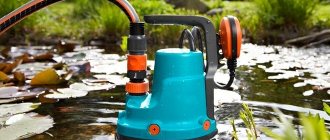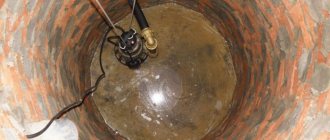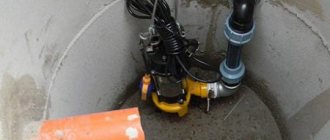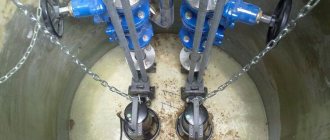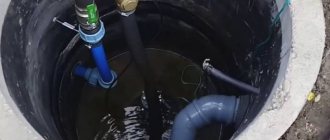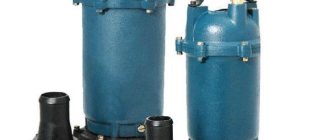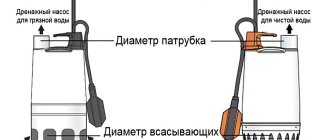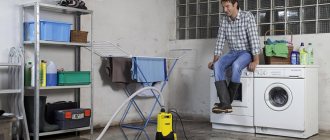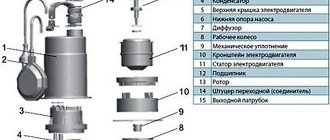When building a country house, it is necessary to create a sewer system. This is necessary to discharge wastewater to a filtration field or to a septic tank. There are various designs in which wastewater moves both by gravity and by forced pumping of liquid. To do this, they use various fecal pumps for sewage – which one to choose is an important question.
Using fecal pumps to pump out sewerage
To pump out wastewater, two types of pumps are used - drainage and fecal. The difference between them is small, but important.
The former are used for pumping dirty liquids containing solid objects no larger than 5 centimeters in size. To protect the working part of the mechanism, a metal mesh is attached to the pump inlet.
Fecal water is noticeably different; it is a thick liquid that often contains fibrous clumps of wool, hair or fabric. They will quickly clog the screen and the pump will stop working. For this reason, a grinder is installed on sewage sewage pumps.
Using fecal pumps in a private home
Owners of private country houses, one way or another, have to clean the sewer system on the site. This can be done by calling a special service with a sewage disposal machine, but such an operation is very expensive, so many people prefer to solve the pumping problem themselves.
Pumping out contaminated water can be done using two types of units - drainage or fecal.
The difference between them, at first glance, seems insignificant, but it is fundamentally important. The first of them are designed for pumping heavily contaminated media, including various solid objects up to 5 centimeters in size. To prevent them from getting inside the device, a metal mesh is installed at the pump inlet.
Fecal water has a slightly different consistency. They are a thick liquid, often including fibrous contaminants in the form of clumps of rags, hair, animal fur and other similar substances. The mesh of the drainage unit becomes clogged with them very quickly, and it stops working.
To eliminate this problem, a grinder is installed on fecal models of sewage pumps in private homes.
Thus, drainage pumps for sewage systems are practically not used in private homes.
Design and principle of operation of a fecal pump
The main advantage of this small mechanism is the ability to move dense waste through a sewer pipe to a height of up to 7 m and a distance of up to 100 m.
Pump device
These are small but complex devices, the design of which includes:
- Frame. It is made of stainless steel, cast iron or plastic. Considering the operation of the mechanism in an aggressive environment, it is desirable to have a stainless steel case;
- Rotor and stator. Pump motor design elements;
- Shaft. Transmits rotation to the working body;
- Seals. Protects the inside of the mechanism from the ingress of aggressive substances;
- Working turbine. Pumps wastewater from the suction to the supply opening.
The mechanism is equipped with brackets necessary for attaching hoses and cables.
Operating principle and technical characteristics of the pump mechanism
Although this is a complex device, it works simply. When the turbine rotates, it carries wastewater under pressure into the sewer pipe, while simultaneously grinding solid inclusions.
Pumping wastewater under pressure is only necessary if plumbing fixtures are located below ground level (in basements or semi-basements). In this case, wastewater cannot flow from the collector into the septic tank by gravity; it must be pumped forcibly.
The daily volume of fecal water and the technical characteristics of the pump are important here:
- Productivity - the amount of waste that the mechanism is capable of pumping in 1 hour (for example, 100-200 l/hour);
- Power consumption - for use in a country house, a low-power pump is enough - no more than 400 W/hour;
- The height of the column (the pump is not at all below the soil level) or the immersion depth of the mechanism - for fecal pumps 15 m maximum;
- Mains voltage – in a private house, it is better to install pumps with an operating voltage of 220 V.
The characteristics of the equipment used for pumping fecal water are varied, but in each case it is possible to select the optimal parameters of the device.
Sewage pumps types/types/varieties
Although there are many different models of such pumps, they are all divided into several types:
Submersible mechanisms are made of durable materials; they always have a float mechanism for turning the device on/off. The pump has a sealed housing; all connections are equipped with gaskets that protect the inside of the device from exposure to aggressive environments. They are mainly used for emptying cesspools, but they are also suitable for pumping out storm drains. They are capable of solving many problems; a submersible fecal pump can even be used to drain a vegetable garden. They are installed at the bottom of the tank, secured to the suction pipe. The float switch is able to turn off the device in time, preventing it from being turned on after the container is empty (because of this, the pump may burn out). The pumped fecal water serves to cool the mechanism. A submersible pump is a very reliable device;
Semi-submersible mechanisms have a smaller outlet pipe diameter. It is capable of pumping wastewater with solid inclusions of maximum 15 mm. But they must be equipped with a device for grinding solids, for this reason they can be used for pumping out wastewater. Semi-submersible mechanisms are mainly installed on a floating platform, which is always at the same level with the pumped liquid. When this device operates, the bottom of the pump is always immersed in liquid, and the top part is in the air;
Surface pumps are placed outside the tank with fecal waste, for this reason they require a protective casing. These mechanisms are low-performance; they can pump wastewater with solid inclusions up to 5 mm in diameter. But the long service life and low cost of the device make it attractive to owners of private houses;
Domestic sewer stations are used for pumping waste fecal water; they allow solving several problems:
- Possibility of pumping out fecal water, along with water coming from other plumbing fixtures installed below the level of the sewer line. Such pumps make it possible to raise wastewater to a height of up to 15 m, thanks to this it is possible to install household plumbing in the basement or basement;
- The use of these devices makes it possible to transport wastewater and fecal matter over a distance of up to 100 m, without thinking about providing the necessary slope. There is no problem with seasonal soil movements, which can deform a long sewer pipe;
- The use of a grinder for large inclusions allows you to obtain a homogeneous mass of fecal waste, which allows you to lay a sewer pipe with a diameter of 40-50 mm;
- These pumps allow you to install a carbon filter, which will prevent unpleasant odors from entering the room.
To select a suitable pump, take into account:
- At what depth is the sewer system laid and are there any differences in the height of the laid pipe;
- Type of wastewater – composition of inclusions and temperature;
- The amount of wastewater that needs to be pumped;
- The need for automatic operation and a suitable way to control the pump.
Household sewage pumping units are small in size and do not require much space.
Feces grinders
First of all, you need to find out what materials need to be crushed:
- From the kitchen sink, where, in addition to fats, food debris gets into the sewer system, leading to clogged pipes;
- The washing machine and sink produce animal hair, hair and fibrous materials when washing fabrics. Combining with fats, they form dense blockages;
- Tampons, all kinds of napkins and paper end up in the sewer system.
All this waste must be processed by a shredder. This device works like a simple meat grinder. The device itself acts as an auger that moves the crushed material. Taking into account the characteristics of the waste being processed, the grids and knives of the mechanism are made from high-strength stainless and alloy steels.
Knives of several shapes are used:
- impellers with blades-knives;
- knife-like meat grinders;
- cylindrical scissors;
- cross secateurs;
- knives in the form of plates.
It is important that no stones or similar objects get into the shredder, otherwise the mechanism may break.
Selecting a fecal pump
To pump out sewerage, you need to choose a device taking into account several characteristics:
- Supply voltage, which affects the energy costs required for pumping wastewater. Usually in your own home you use a voltage of 220 volts, but you can also buy pumps designed for 380 volts;
- Power consumption for such a device, this characteristic should not be less than 400 watts. This directly affects the pressure of the pumped waste, which is necessary to overcome the resistance of the pipeline contents;
- For submersible pumps, the possible immersion depth of the device must be taken into account. And for external ones - the permissible length of the intake sleeve;
- The performance of the mechanism is important - the volume that can be pumped in a certain time. It should not be less than the calculated indicators of incoming wastewater. In most cases, 400 watts of pump power is enough to pump out 80-100 liters of wastewater per minute;
- Be sure to equip the device for removing waste with automatic on/off devices. Protection against engine overheating, short circuit, and electrical breakdown is required. It is necessary to provide for the installation of check valves that make the reverse flow of wastewater impossible.
It is important to consider the reputation of the equipment manufacturer. Now on the market you can find many fakes that copy equipment from reputable and well-known manufacturers. For this reason, it is necessary to study the source of origin of the pump and all quality certificates for the product.
How to choose a drainage pump for draining groundwater and wastewater?
The main purpose of drainage pumps is to pump out water.
This task becomes especially relevant in the spring, when there is a high risk of flooding of basements, wells and cellars with melt water. To protect your home or cottage from floods, or to organize a wastewater disposal system, we offer a wide selection of submersible drainage and sewage pumps.
The main parameters for selecting any pump are its flow (flow) and pressure.
The pressure-flow characteristic shows with what pressure the pump pushes a certain volume of liquid per unit time. Most often, the pressure is indicated in meters (m), and the flow rate in cubic meters per hour (m³/h) or in liters per minute (l/min). This characteristic shows the dependence of flow on pressure and is presented in the form of a graph or table in the technical documentation for the pump. This data is necessary to determine the optimal operating mode of the pump - its operating point.
To select a specific model of drainage pump, first of all, it is necessary to calculate the distance over which you want to pump out water. It is believed that 1 meter of vertical pressure approximately corresponds to 10 meters of horizontal pressure. For example, it is necessary to divert water from a basement 3 meters deep to a waste pit 40 meters from the house.
We obtain the required pressure: 3 (m) + 40/10 (m) = 7 meters (without taking into account pressure loss in the pipeline).
As a pressure pipeline for mobile operation of drainage pumps, it is recommended to use flexible pressure-suction PVC hoses reinforced with a spiral, or special textile hoses with an internal waterproofing coating. Hose “To Berlin!” Comes already equipped with a connecting fitting and a reel for easy storage. When installing a drainage pump permanently, both flexible and rigid pressure pipelines made of polypropylene pipes, HDPE and other materials are used.
IMPORTANT! The diameter of the pressure pipe must be greater than or equal to the diameter of the pressure pipe!
The calculation of the volume of pumped liquid consists of the volume of the room, pit or container and the volume of incoming liquid per unit of time. For example, you need to drain a flooded basement measuring 4x4x2 meters in no more than 4 hours.
We get the required flow rate: 32 m³ / 4 h = 8 m³/h (excluding incoming liquid).
The exact volume of incoming liquid can only be calculated by organizing a drainage system from water collection points (shower, sink, toilet, washing machine, etc.). Most often, for domestic use, a flow rate of up to 14 m³/h is required.
IMPORTANT! Manufacturers of pumping equipment usually indicate maximum characteristics on the information plate!
For example, the information plate of the pump states: “Pressure (max) – 11 m”, “Flow (max) – 15 m³/h”. This means that at a head of 11 meters the flow rate is 0 m³/h, and, conversely, at a flow rate of 15 m³/h the head is 0 meters. This data is not enough to determine the operating point, but, most often, for household drainage pumps, the maximum pressure specified by the manufacturer should be approximately 3 meters greater than the calculated one, and the maximum flow rate should be 2 times greater than the calculated one. In our example, with a design head of 7 meters and a flow rate of 8 m³/h, a pump with maximum characteristics of about 10 meters and 16 m³/h is required, respectively.
For a more accurate selection, you need to refer to the graph or table with the pressure-flow characteristics of a specific pump model. It is necessary to divide the graph into 4 equal parts and draw 2 straight lines that correspond to our calculated characteristics. The intersection point with the graph of a suitable pump should be approximately in the middle of the graph - in its 3rd part. The figures below show graphs of two models of pumps of the same series, which clearly shows which pump is suitable for our design requirements.
A mandatory parameter for selecting a drainage pump is its throughput capacity of mechanical impurities.
For clean and lightly contaminated water, drainage pumps with a throughput capacity of mechanical impurities of up to 5 mm are suitable. Unipump SUB pump series.
For dirty water with a high content of suspended matter, it is recommended to use pumps capable of pumping large particles up to 35 mm. Series of pumps Unipump VORT, Unipump INOXVORT.
To pump water containing feces and other long-fiber inclusions, special pumps with a grinding mechanism are required. Espa VIGICOR, Unipump FEKACUT.
Pumps with pressure ports of 35 mm or larger are also suitable. Pedrollo BC, Unipump FEKAPUMP.
The parameter that affects the reliability and mobility of the pump is the material of manufacture.
Drainage pumps made of plastic and other composite materials are not subject to corrosion and are lightweight, which is convenient for periodic use. Also, these pumps are the most budget-friendly.
Pumps made of stainless steel, compared to plastic ones, have increased wear resistance, while their weight is slightly higher.
Cast iron drainage pumps are the most reliable and durable, most often used for permanent installations and in difficult operating conditions.
Operating mode and type of control of drainage pumps.
All drainage pumps are ready for manual operation, while the vast majority of them are equipped with float switches for automatic operation and protection against dry running.
IMPORTANT! Never allow the pump to operate without water! This is one of the most common causes of breakdowns!
The on and off level is regulated by a “float” cable, which is secured in a special clamp on the pump body. The float switch is kept at the water level and if it rises, the pump turns on; when the water level drops, the pump turns off.
IMPORTANT! For correct operation of the float switch, space is required for its free movement!
In narrow places with limited space, drainage pumps with a level switch built into the housing (for example Unipump SUB) are used. If it is necessary to pump out water to a minimum level of 1-2 mm, including in automatic mode, we recommend using a Karcher SP 6 FLAT INOX pump with an Aquasensor electronic sensor.
Design features, limitations and application tips.
Household drainage pumps have restrictions on the temperature of the pumped medium. Temperatures are usually allowed in the range from +1 to +35°C. To pump hot water, special pumps with a cooling casing are used. For example, Grundfos pumps of the Unilift KP series.
There is also a limit on the depth of immersion in water. Most often, it is allowed to immerse the pump in liquid to a depth of 3 to 5 meters. If exceeded, there is a risk of depressurization of the electric motor and danger of electric shock.
IMPORTANT! Never move the pump by the electrical cable! Always check it for damage before starting work!
To extend service life and avoid blockages, it is recommended to install the drainage pump on a platform 2-3 cm above the bottom level. It is also possible to use a pump with a special “turbulence” device, which continuously creates a turbulence in the suction area, preventing the sinking and deposition of suspended particles. Wilo TMW.
So, to select a specific drainage pump model, we will use the example we considered with a flooded basement. We need a pump capable of pumping melt water with a pressure of 7 meters and a flow rate of 8 m³/h. To avoid clogging with possible debris from the basement, choose a pump that can pump cold dirty water with particles up to 35 mm in diameter. Material – stainless steel, like a “golden mean” between plastic and cast iron. Thus, the UNIPUMP INOXVORT 1100 SW drainage pump fits the given requirements.
Of course, to select high-power pumping equipment for complex systems or industry, a project with a full hydraulic calculation is required, which is best entrusted to professionals.
If you have any questions or need help selecting a pump, our specialists are always ready to help.
Drainage pumps in our catalog →
Rules for using equipment
Every technically complex mechanism can quickly break down if used incorrectly. For example, the operation of a submersible pump after pumping liquid from a container. This type of pump uses pumped wastewater for cooling. If the drains run out and the pump continues to work, the engine will quickly burn out from overheating.
The same thing will happen if you use the equipment for other purposes. For example, it is dangerous to pump out drainage water with it. The reason is that there are a lot of hard stones in the pumped liquid. In the shredder, these particles will damage the knives, and the pump will no longer be able to work normally.
Before putting the fecal pump into operation, you must familiarize yourself with the operating rules. Violation of them may result in early termination of the equipment warranty.
Main manufacturers of fecal pumps
This equipment is produced by many manufacturers. Common in our market:
Pedrollo pumps. Mechanisms of this brand are used for pumping very dirty wastewater. The most common are the VXm MC/MCm lines. Of these, the first ones are not very powerful; their operation requires power from a 220 volt network, the rated power of the pumps is 0.6 kW. These are the most common devices for pumping out fecal water in private homes. According to the instructions, it is allowed to pump wastewater with a solid element size of up to 35 mm. Technical characteristics of the equipment:
- voltage 220-380 volts;
- maximum liquid level to the bottom of the container – 40 mm;
- device productivity 15-66 l/hour;
- Pumps of this brand can be immersed to a depth of 8-22 m;
- the diameter of the outlet pipe is 1.5-2.5 inches.
Fecal pump Grundfos SEG. The unit is equipped with a grinder and is designed for pumping sewage, drainage water, and wastewater. It is capable of pumping wastewater over considerable distances, but the pipe size is limited to 40 mm.
Main characteristics of the equipment:
- body material – cast iron;
- the pump is equipped with an impeller adjustment system;
- 2 relays are installed to protect the device from overheating;
- used for pumping to a depth of 10 meters;
- the maximum permissible temperature of the pumped liquid is 40 degrees.
Sewage pumps Gillex. The company produces two types of pumps – Fekalnik and Drainazhnik, the names of which indicate their purpose. The permissible size of solid inclusions is 35 mm.
Main technical characteristics:
- productivity 160-260 liters per hour;
- immersion depth – 6-11 m;
- installation of a float switch.
Sulzer – pumps for pressure sewerage. This is a station for pumping fecal wastewater with its simultaneous processing into a liquid mass. Their advantage is that they are quick to install and get up and running. The station is equipped with a reliable check valve and a powerful solids grinder.
The Vortex fecal pump is designed for pumping wastewater with strong fibrous contaminants. Used for domestic purposes. Main technical characteristics:
- power 450-1500 watts;
- pressure 9-18 meters;
- productivity 16-24 cubic meters per hour;
- solid inclusions of 15-42 millimeters are allowed;
- permissible liquid temperature is 40 degrees.
Using a pump for forced pumping of sewage is often a forced decision that is influenced by the surrounding landscape.
Installation of a fecal pump
Installing a fecal pump is not a difficult, but responsible job; you can do it yourself. In difficult cases, if there is no necessary experience, it is better to invite specialists.
Pump installation
Before installing the equipment, it is necessary to prepare the installation site and connect the electrical panel. Sometimes it is necessary to additionally install a fecal pump in a separate room - in the kitchen or bathroom, and so on. The most important thing in this case is not to connect the devices to one electrical panel; for each of them you need to provide its own connection and its own input into the sewer system.
Important! Take the wastewater temperature into account. A dishwasher or washing machine in the kitchen requires the use of a pump that is designed to pump hot liquid.
When installing a fecal pump, you need to follow a few simple rules:
- connect the mechanism to a separate electrical panel;
- secure the mechanism well;
- an external fecal pump is mounted on the edge of a container with waste water;
- the submersible pump must be lowered directly to the bottom;
- semi-submersible pump - install so that the upper part is at the top and the working mechanism is lowered into the liquid.
Installing the device in a toilet is characterized by the use of a larger diameter sewer pipe, and it is necessary to install a pump with a grinder - it is necessary to grind toilet paper and feces. The mechanism should be located no further than 40 cm from the toilet.
After the pump is finally installed and connected to the electrical network, it is necessary to test the equipment and adjust the operation of the float switch according to the liquid level. Ev container is filled with water to the minimum level, this will be the shutdown point. After this, water is poured in until the pump switch is activated. If you notice noises or malfunctions in the operation of the equipment, it is advisable to eliminate them immediately. If there are no comments, you need to seal the well.
What to consider when choosing a pump?
When contacting a store to select a sump pump, you must be prepared to provide the following information: 1. Accurate determination of the pumped medium: clean water, water with a low content of various inclusions, heavily polluted water, industrial waste, etc. 2. Accurate determination of the needs for a certain type of pump: let's say, there is no point in buying a complex system for several tens of thousands of rubles for a family of two people, who also live in the house not permanently, but seasonally. 3. Data for calculating hydraulic resistance: the length of the vertical and horizontal sections of the pipeline, its diameter, the number of bends and the material from which it is made. 4. Planned pump performance.
Warranties and service life
As a rule, the warranty for cheap pumps is one year, for “middle class” and expensive devices - up to 3-5 years, depending on the manufacturer. The declared service life of drainage and drainage-fecal pumps is up to 10 years, but this simply means “greenhouse” operating conditions, which do not exist in reality: absolutely clean water without sand and chemically aggressive media, no “surges” in the supply network, turning the device on and off as rarely as possible, since when starting the electric motor, the starting currents are many times higher than the rated ones... The actual service life of any “middle class” pumps in Russian conditions is hardly more than 5–6 years, although, undoubtedly, everything depends on the frequency use.
I would like to note the fact that plastic parts, rubber gaskets and seals tend to “age”, even if the conditions for maintaining the pumps are strictly observed. That is why many manufacturers introduce amendments to warranty obligations: for example, “the warranty period is three years from the date of purchase, but no more than five years from the date of manufacture of the product” - when purchasing a pump, you should pay close attention to this point.
How to choose a fecal pump for sewage
If you need equipment for pumping out wastewater, it is important to pay attention to several characteristics of the device when purchasing.
The mechanism will work for a long time if you take into account:
- required performance;
- sewer pipe diameter;
- total amount of wastewater;
- pump immersion depth;
- pressure;
- type of mechanism;
- pump power;
- additional options – chopper, liquid volume control;
- the manufacturer of the product.
Maximum head
This characteristic indicates the pressure that the pump can create. This is the second most important indicator of the effectiveness of the mechanism. It is measured in meters, as this allows you to understand to what height the pump is capable of pumping liquid. It is necessary to choose a pump so that its pressure is sufficient to lift the liquid to the required height. Greater pressure can only be achieved by using expensive, high-performance devices.
Suction/immersion depth
It is necessary to take into account the characteristic of the device, which depends on the location of the personal plot - the immersion depth. This indicator is determined by the purpose of the mechanism, and affects the ability to pump wastewater; it happens within 3-20 m.
Power
When choosing a suitable pump for pumping sewage, consider its power. This directly affects the performance of the equipment, the ability to pump out viscous substances containing solid particles and the energy costs during operation. This characteristic affects the pressure; the power depends on the manufacturer and model.
Working temperature
Any fecal pumps intended for domestic sewage are divided into 2 types:
- For cold wastewater - the liquid temperature does not exceed 45 degrees;
- For hot wastewater – liquid temperature up to 90 degrees.
When only cooled liquid enters the sewer, it is better to use models designed for cold water, but it is not prohibited to install pumps for hot water (but they are more expensive). These pumps are used in private homes. Hot water enters the sewer system from the washing machine and dishwasher and during emergency discharges of coolant from the heating system.
Automatic control
To control the pump when pumping out wastewater manually, you will have to turn it on and off yourself all the time, and this is inconvenient. Will be required to be near equipment frequently. It is better to purchase devices that include:
- A float is an element that determines the height of wastewater in a tank; it allows you to turn the equipment on and off in a timely manner;
- Thermal relay is a device that is triggered when the electric motor is significantly heated, this allows you to turn off the power to the pump in a timely manner, preventing overheating.
To reduce the risk of clogging of the pump with a grinder, manufacturers sometimes install a self-cleaning device for the mechanism that crushes large particles. This makes it possible to increase the service life of equipment without stops and interruptions in operation. Cleaning the chopper yourself further reduces the risk of motor overheating.
The most efficient and most reliable fecal pumps are devices with a metal body and working part. For this purpose, stainless steel and cast iron are used. Plastic products cost less, but when working in an aggressive environment they will fail faster.
Device and purpose
A pump with a grinder is a surface sewer pumping installation that allows you to organize the removal of wastewater where it is not possible to do this using a gravity system. This is a small plastic container with a powerful built-in pump that pumps waste into the sewer. The movement of drains can be both vertical and horizontal. There are installations with a grinder that can be connected to toilets, and there are those without a grinder - for “gray” waste from sinks, showers, bidets, etc.
The sewer pump for toilets and other plumbing fixtures is small in size
Application area
A sewer pump is used in cases where it is impossible to create a gravity sewer system. In most cases, when a plumbing fixture, washing machine or dishwasher is installed below the entrance to the sewer. This is why forced sewage pumps were invented. This solution allows you to move bathrooms and technical rooms to basements or semi-basements.
You can connect sanitary pumps in the bathroom, toilet, kitchen, and laundry room. In any room where water drainage is required and the sewer drain is far away
A pump with a grinder is also installed if it is decided to build a bathroom after the renovation is completed and the sewerage system is not connected to the place where the plumbing is supposed to be installed. In this case, the installed equipment is connected to a compact sewage pump, and it is connected to the sewer. What is the difference? In the following:
- the diameter of the outlet pipes for the sewer pump is much smaller than for the gravity system (28-40 mm);
- drains can rise up to a height of up to 9 meters;
- horizontal wastewater disposal is possible up to 100 meters (requires a minimum slope of 1-4%).
All this allows you to organize a connection to an existing sewer system almost anywhere at minimal cost.
Design and principle of operation
The sewage pump consists of a plastic storage container and a pump. Some models that can be connected to a toilet have a grinder. The filling level is controlled by a sensor. When it is triggered, the grinder and pump are turned on, and wastewater is pumped into the sewer system. The shutdown is controlled by a second sensor - it turns off the power when the wastewater level drops below a certain level. This is a simplified algorithm for the operation of pressure sewerage.
Sewage pump with grinder: device
There are sewage pumping stations designed to connect devices of various types and quantities. The simplest one is designed to connect one or two devices, the most productive one has three additional pipes (and one main one). Accordingly, the container has one or more inlet holes (depending on the model) and one outlet hole. Pipes coming from the plumbing are connected to the inlets, and the outlet is connected to the sewer.
For pumping out high-temperature wastewater from washing machines, dishwashers, and bathtubs, there are special models made of heat-resistant materials. A conventional sewage pump cannot cope with such a load. Therefore, to connect such equipment you need to look for certain models.
